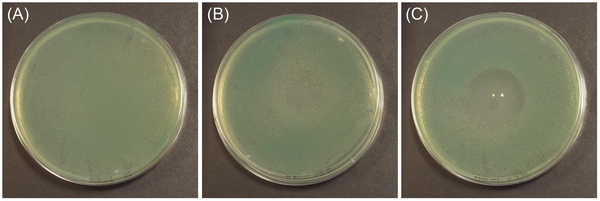Plasma jet zaps superbugs
October 4, 2012

Bacterial growth inhibition zones (credit: Mahmoud Y. Alkawareek, Qais Th. Algwari, Garry Laverty, Sean P. Gorman, William G. Graham, Deborah O’Connell, Brendan F. Gilmore/PLoS ONE)
Scientists at Queen’s University Belfast have developed a new technique with the potential to kill off hospital superbugs like Pseudomonas aeruginosa, C. difficile and MRSA.
The novel method uses a cold plasma jet to rapidly penetrate dense bacterial structures known as biofilms that bind bacteria together and make them resistant to conventional chemical approaches. The new approach developed by scientists in the School of Mathematics and Physics and the School of Pharmacy at Queen’s passes electrical currents through flowing gas mixtures to create a wide variety of reactive species. These then effectively penetrate biofilms of Pseudomonas aeruginosa and MRSA and rapidly kill the bacteria within.
Currently antibiotics and disinfectants are used to target bugs in hospitals like Pseudomonas aeruginosa, C. difficile and MRSA. Effective in killing individual bacteria, they are often ineffective against complex organised communities of bacteria.
Professor Bill Graham, from the Centre for Plasma Physics at Queen’s, said: “When bacteria congregate on surfaces they produce a kind of glue which joins them together in complex communities, known as biofilms. Instead of individual bacteria, they form a resistant film or layer and bind themselves together.
This often makes it impossible for antibiotics to penetrate through and kill the bacteria deep within this protective layer. Bacteria growing like this, as is often seen with superbugs in hospitals, are often more than 1000 times more tolerant to antimicrobial agents like antibiotics and disinfectants compared to free-floating bacteria.
“The technique we’ve used, known as a cold plasma jet, creates a number of agents which rapidly kill bacteria, even within mature biofilms. Not only does it attack the bacteria but this synergistic approach attacks the biofilm structure killing the bacteria deep within.”
Dr Brendan Gilmore, from the School of Pharmacy at Queen’s, said: “In the present study we have looked at Pseudomonas aeruginosa, which causes a number of serious infections in patients with chronic lung disease like cystic fibrosis, wounds and hospital acquired infections. It is particularly harmful to hospital patients with compromised immune systems. Other applications could include MRSA and other drug resistance superbugs like C. difficile and its spores. We are currently investigating these and some types of viruses.
“This approach has the potential to control hospital superbugs. These ‘cold’ plasmas could be used widely in hospitals, surgeries and in the community as hand held devices for rapid decontamination of surfaces, including the skin, or be incorporated into bigger devices for decontamination of larger areas. Their ability to rapidly decontaminate surfaces has the potential to curb the spread of harmful bacteria, including multidrug resistant bacteria such as MRSA.”